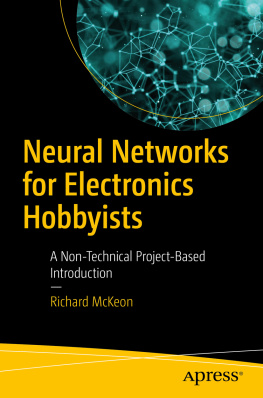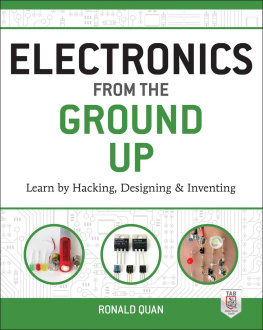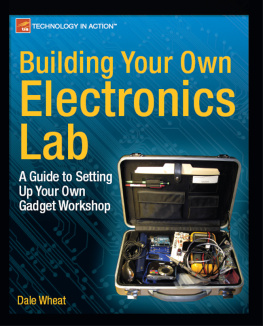
Copyright 2015 by McGraw-Hill Education. All rights reserved. Except as permitted under the United States Copyright Act of 1976, no part of this publication may be reproduced or distributed in any form or by any means, or stored in a data base or retrieval system, without the prior written permission of the publisher.
ISBN: 978-0-07-184381-2
MHID: 0-07-184381-7
The material in this eBook also appears in the print version of this title: ISBN: 978-0-07-184380-5, MHID: 0-07-184380-9.
eBook conversion by codeMantra
Version 1.0
All trademarks are trademarks of their respective owners. Rather than put a trademark symbol after every occurrence of a trademarked name, we use names in an editorial fashion only, and to the benefit of the trademark owner, with no intention of infringement of the trademark. Where such designations appear in this book, they have been printed with initial caps.
McGraw-Hill Education eBooks are available at special quantity discounts to use as premiums and sales promotions or for use in corporate training programs. To contact a representative, please visit the Contact Us page at www.mhprofessional.com.
Information contained in this work has been obtained by McGraw-Hill Education from sources believed to be reliable. However, neither McGraw-Hill Education nor its authors guarantee the accuracy or completeness of any information published herein, and neither McGraw-Hill Education nor its authors shall be responsible for any errors, omissions, or damages arising out of use of this information. This work is published with the understanding that McGraw-Hill Education and its authors are supplying information but are not attempting to render engineering or other professional services. If such services are required, the assistance of an appropriate professional should be sought.
TERMS OF USE
This is a copyrighted work and McGraw-Hill Education and its licensors reserve all rights in and to the work. Use of this work is subject to these terms. Except as permitted under the Copyright Act of 1976 and the right to store and retrieve one copy of the work, you may not decompile, disassemble, reverse engineer, reproduce, modify, create derivative works based upon, transmit, distribute, disseminate, sell, publish or sublicense the work or any part of it without McGraw-Hill Educations prior consent. You may use the work for your own noncommercial and personal use; any other use of the work is strictly prohibited. Your right to use the work may be terminated if you fail to comply with these terms.
THE WORK IS PROVIDED AS IS. McGRAW-HILL EDUCATION AND ITS LICENSORS MAKE NO GUARANTEES OR WARRANTIES AS TO THE ACCURACY, ADEQUACY OR COMPLETENESS OF OR RESULTS TO BE OBTAINED FROM USING THE WORK, INCLUDING ANY INFORMATION THAT CAN BE ACCESSED THROUGH THE WORK VIA HYPERLINK OR OTHERWISE, AND EXPRESSLY DISCLAIM ANY WARRANTY, EXPRESS OR IMPLIED, INCLUDING BUT NOT LIMITED TO IMPLIED WARRANTIES OF MERCHANTABILITY OR FITNESS FOR A PARTICULAR PURPOSE. McGraw-Hill Education and its licensors do not warrant or guarantee that the functions contained in the work will meet your requirements or that its operation will be uninterrupted or error free. Neither McGraw-Hill Education nor its licensors shall be liable to you or anyone else for any inaccuracy, error or omission, regardless of cause, in the work or for any damages resulting therefrom. McGraw-Hill Education has no responsibility for the content of any information accessed through the work. Under no circumstances shall McGraw-Hill Education and/or its licensors be liable for any indirect, incidental, special, punitive, consequential or similar damages that result from the use of or inability to use the work, even if any of them has been advised of the possibility of such damages. This limitation of liability shall apply to any claim or cause whatsoever whether such claim or cause arises in contract, tort or otherwise.
In memory of Jack,
mentor and friend
About the Author
Stan Gibilisco, an electronics engineer and mathematician, has authored multiple titles for the McGraw-Hill Demystified and Know-It-All series, along with numerous other technical books and dozens of magazine articles. His work appears in several languages. Stan has been an active Amateur Radio operator since 1966, and operates from his station W1GV in the Black Hills of South Dakota, USA.

Contents

Introduction
If you like to invent, design, build, test, and tweak electronic circuits and gadgets, then youll like this book. Its aimed at beginning and intermediate-level hobbyists and home experimenters, although technicians and engineers should find it useful as a reference from time to time.
offers suggestions for setting up a basic home electronics workshop: a sturdy bench, plenty of organized storage space, a test meter, an ample supply of components and connectors, a modest computer, and a reliable source of electricity. Once you have your lab together, Ill show you a simple experiment you can do there.
describes the types of resistors available for use with electronic circuits, defines some of the more technical jargon that youll encounter, offers a few useful formulas for resistance calculations, and concludes with three simple experiments you can do without spending a lot of time or money.
offers a brief refresher on capacitance, along with information about the types of capacitors you can easily obtain and use in your electronics adventures. Youll learn a few capacitance-relevant formulas. Two experiments will give you some insight into how capacitors behave and how to measure their values.
. Youll learn about coil core types and optimum coil configurations for audio versus radio-frequency circuits. You will also be shown some simple inductance calculations. In the experiments, youll build a simple DC electromagnet and an inductor-based galvanometer.
involves transformers and their uses, from changing voltages to matching impedances. Youll learn formulas to help you choose the best transformer for your evolving creation. Youll test a small transformer module and then conduct an experiment where you connect two identical modules back-to-back.
gives you an overview of diode applications including rectification, frequency multiplication, signal mixing, switching, voltage regulation, amplitude limiting, frequency control, oscillation, and DC power generation. Youll do a couple of experiments to reduce DC voltage and convert AC to DC.
deals with the fundamentals of bipolar and field-effect transistors, including metal-oxide devices. Youll learn which transistors work best in particular circuits. In the experiments, youll use a multimeter to test a bipolar transistor and a junction field-effect transistor (JFET) for proper operation.
describes integrated circuits (ICs), emphasizing the advantages but noting the limitations. Youll get familiar with linear versus digital IC technology, learn IC functions, and fortify your understanding of binary logic hardware. In the experiments, youll use resistors and diodes to simulate the operation of OR and AND gates.
offers an assortment of hardware manipulation and lab techniques, such as cells and batteries, wire and cable splicing, soldering and desoldering, commonly used connectors, oscilloscopes, spectrum analyzers, frequency counters, and signal generators.
Next page









